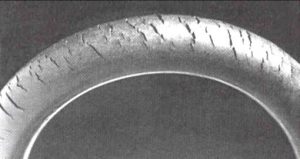What Causes O-Ring Cracking?
Apr 17, 2019
 Having an O-ring fail in an application is never a fun event. At best, it will mean some downtime and production delays, at worst it could lead to contamination of products requiring a major clean down to rectify.
Having an O-ring fail in an application is never a fun event. At best, it will mean some downtime and production delays, at worst it could lead to contamination of products requiring a major clean down to rectify.
One of the reasons O-rings can fail is because the material has cracked. If you’ve removed an O-ring from its application and have discovered multiple cracks, you need to understand what’s caused this issue so you can effectively prevent it from happening again.
Why do O-rings crack?
The most common cause of O-ring cracking is ozone cracking, also called ozonolysis. This mainly occurs in nitrile rubber O-rings, including Buna and Buna-N varieties.
Nitrile rubber is a polymer made up of units of carbon, hydrogen and nitrogen. The makeup of the nitrile molecules is such that there is an inherent ‘weak spot’ within the molecule. This spot can be susceptible to an oxygen atom being ‘donated’ from ozone, which breaks the chain and weakens the material.
Over time, these tiny cracks caused by ozonolysis get larger and more serious, until eventually they are large enough to be seen with the naked eye.
Preventing O-ring cracking
The molecules of oxygen which cause O-ring cracking are not from the general oxygen that we breathe. Breathable oxygen is O2, which is molecules joined in pairs. However, sometimes oxygen joins in threes, creating a substance known as ozone.
In the upper atmosphere, ozone is the layer that protects us from the harmful rays of the sun and gives the sky that beautiful blue colouration. In the lower atmosphere, the presence of ozone can cause health problems, breathing issues and, even in very small concentrations, O-ring cracking.
The best way to prevent O-ring cracking is to keep them away from sources of ozone production. These include UV light, electrical arcing and electromagnetic fields. To store your O-rings safely, you need to:
- Keep them away from UV light, including sunlight and fluorescent light
- Keep them away from electrical arcs such as electric motors
- Store them in an un-stretched state
Nitrile O-rings should be assembled wet, using a grease to protect them from ozone. When fitting them, we recommend adding the mating part within 24 hours of installing them on the fitting itself. If you need to store them in a stretched state, use an airtight bag to protect them.
